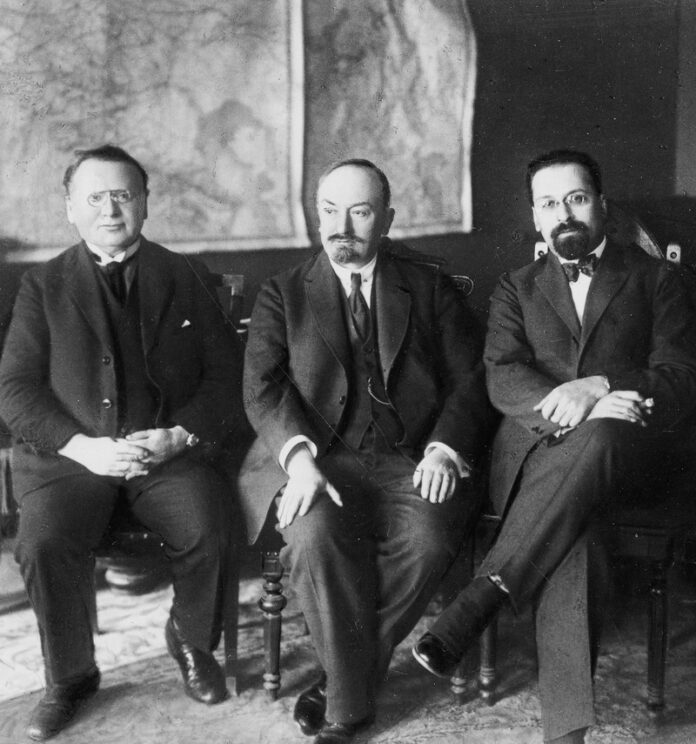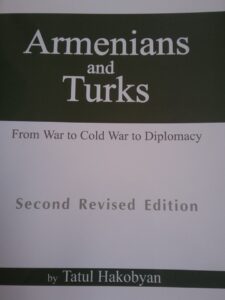After the sovietisation of Armenia, the ARF was accused of not having paid attention to the Bolsheviks, which was the reason that the Bolsheviks behaved badly towards Armenia. But from the first day of the Bolshevik Revolution, when Soviet Armenia did not even exist, the ARF had had ties with it. Members of the ARF Bureau Hakob Zavriev and Ruben, advocates of close ties, were negotiating with Stepan Shahumyan and other Bolsheviks in Tiflis, while in Yerevan, Aram Manukyan was doing so with Poghos Makintsyan and Arshavir Melikyan. When the Bolsheviks were forced to leave Tiflis for Baku, the ARF-Bolshevik co-operation continued there. It is not true that the ARF, being in contact with Denikin, maintained no contact with the Bolsheviks or that ARF relations with the Bolsheviks only began after the Levon Shant [delegation] went to Moscow [in May of 1920].
As early as 1919, Armenian leaders sensed that Armenia might lose out as a result of Turkish-Bolshevik friendship. The Armenian communists indignantly rejected the existence of such co-operation and considered the news being disseminated through the pressto be the result of “Dashnak provocation”. In Vratsyan’s words, at that time the Bolsheviks “still considered friendship with the slaughtering Turks to be a disgrace”. In the beginning of 1920, the ARF Bureau, concerned about Turkish-Bolshevik friendship, sent several members, including Ruben and Vratsyan, to Tiflis on a mission to establish relations with the Russian Communist Party’s Caucasian Bureau (Kavburo) and to clarify the details of Turkish-Bolshevik co-operation.
After the visit and meetings in Tiflis, the ARF was finally convinced that there was friendship between the Bolsheviks and the Kemalists, that the Bolsheviks were placing great importance on the Kemalist movement and had decided to give considerable financial and military assistance to the Turks, and that, in the light of that co-operation, Armenian interests were hardly likely to be taken into account.
The first steps in the Bolshevik-Kemalist co-operation were taken by Khalil Pasha [Menteşe]. Yet another Pasha, Ali-Fuat [Cebesoy] who left for Moscow in February 1921 as the first Kemalist ambassador, writes in his memoirs that, on Kemal’s orders, Khalil arrived in Baku towards the end of 1919, and from there he went to Moscow and met with Grigorii Chicherin and Lev Karakhan. He presented the situation in the Turkish vilayets to the Russians in detail and declared “Turkish determination to defeat the Armenians and the Constantinople government, which was subject to the English”. Making the Bolsheviks understand that a new government would shortly be established, he placed importance on their sending arms and munitions by sea, prior to the establishment of relations.
Not only were the interests of the Armenian people ignored, but, towards the end of 1920, the Kemalists and Bolsheviks divided Armenia between themselves. Till then, the future had seemed hopeful. Armenia had entered its third year of independence with extended borders, hunger and poverty had been overcome. The international situation also seemed to be to Armenia’s advantage. On June 19, 1920 the republic was de facto recognised – admittedly without pre-determination of future borders. Armenia’s independence was recognised by Great Britain, France, and Italy in the name of the Supreme Council of the Paris Peace Conference.
News of the recognition reached Yerevan on January 23. Splendid events, nationwide rallies, and military parades were organised in the capital, Kars, and other cities. A short time later, on February 11, 1920 Anton Denikin de facto recognised Georgia, Azerbaijan, and Armenia.
Other states adjacent to the Entente such as Belgium, Greece, and Poland also recognised Armenia. The United States of America recognised Armenia’s independence on April 23, 1920.
An Armenian delegation was invited to the San Remo Conference, where the draft for the peace treaty to be signed with the Ottoman Empire, the defeated side in the First World War, was to be drawn up. The decisions taken concerning the Turkish Empire at this conference served as a basis for the signing of the Treaty of Sèvres. At San Remo, the Supreme Council of the Allied Forces decided on April 26 to apply to the President of the United States with two requests: the first, to accept the mandate for Armenia, and the second, to arbitrate in the matter of the borders between Armenia and Turkey.
Armenia had established diplomatic representations in Paris, Washington, Rome, Berlin, Helsinki, Moscow, Tiflis, Baku, Kiev, London, Constantinople, Athens, Rio de Janeiro, Tehran, and also in Austria, Hungary, Czechoslovakia, and Poland.
Several states had diplomatic, consular, and political representations in Armenia. Georgia had a plenipotentiary representation in Yerevan and consular representation in Gharakilisa. The Persian consulate had already been established during the time of the Tsar. An Azerbaijani diplomatic mission and consular section were functioning in Yerevan. In the summer of 1920, Soviet Russia appointed its diplomatic and consular representatives to Armenia. Of the European countries, only Italy formally appointed a representative to Armenia. The main residences of the military-political and diplomatic representations of Great Britain, USA, and France were in Tiflis.
Both the Turks and the Azerbaijanis were meanwhile drawing up their agendas with the Bolsheviks.
On 6 February 1920, in a telegram to Karabekir, Mustafa Kemal elaborated on how the Western powers had plotted to separate the Turks from the Bolsheviks by supporting Armenia, Georgia, and Azerbaijan. Kemal further stated that the Caucasus was “the only possible front” where the Turkish national movement could initiate a counter attack against the Allied Powers. If the three Transcaucasian states, Kemal continued, could constitute a pro-Western barrier, this would be the end of all hopes for the establishment of an independent Turkish state. Therefore, Kemal urged, the Turks should do everything in the Caucasus to facilitate Bolshevik control of the region.
This support from Ankara provided an extra boost to the Bolsheviks’ Caucasian campaign, drawing a significant part of the Turkic Muslim population of the region to the side of Bolsheviks. During the winter of 1919-20, it was apparent that the tide in the Caucasus had already turned in favour of the Bolsheviks, who were enjoying the full support of the Turkish nationalists. The British, who had already withdrawn their troops from the region, were nervous but passive bystanders of Caucasian affairs.
Kemal, as soon as he heard about the occupation of the Ottoman capital, instructed Karabekir to initiate the necessary arrangements to establish immediate contact with the Bolsheviks for a united front in the Caucasus.
On 26 April 1920, a letter from Ankara signed by Kemal was dispatched to Moscow. Kemalists were convinced that only co-operation with the Soviet government would provide the Turks with vital material and diplomatic support.
The contents of Kemal’s telegram show that the Turks unequivocally approved the attack on the Caucasus by the Bolsheviks.
The letter starts with the consent of the Ankara government “to join the fight of Soviet Russia” with “all our power.” According to Kemal, the Turkish government accepted the responsibility of compelling Georgia and Azerbaijan “to enter into union with Soviet Russia… [while] ready to undertake military operations against expansionist Armenia.”
The agreement signed between Ali Agha Shikhlinski, aide to the Azerbaijani military minister, and Kâzim Karabekir in Erzurum in April 1920 was to replace the secret Turkish-Azerbaijani Treaty signed in November 1919 in Constantinople. One of the articles of the document signed in Erzurum states that if “Armenia attacks Azerbaijan” and if “Turkey’s eastern regions are divided and joined to Armenia,” in both cases “both sides of the agreement will protect each other’s interests and will work together as one unified army.”
On the evening of April 27, 1920, the Azerbaijani parliament approved the decision to hand over authority to the Bolsheviks. Azerbaijan was proclaimed as soviet on April 28. The Azerbaijani army crossed over to the side of the new authorities, with no resistance. Mustafa Kemal’s agenda– to hand Azerbaijan over peacefully to Russia – was realised. According to Chicherin, “The Kemalists achieved close relations with us through Azerbaijan, where a group of their sympathisers had assisted the revolution and the invitation of the Russian Red Army on behalf of the Revolutionary Azerbaijani Government.”
The Georgian Menshevik government decided to provide armed assistance for the Musavat government, being aware that, after Azerbaijan, the Russian forces were going to invade Georgia. However, that assistance was not given. The reason for this was explained by Noi Zhordania thus: “The Bolsheviks were moving like an express train without battles, which meant [that they were moving] with Azerbaijani agreement. They had travelled a hundred miles in six hours. The Bolsheviks arrived with negligible forces– two armoured trains. Major forces weren’t needed to capture the armoured trains and toss the Bolsheviks back, but since there was no desire to do so, the entrance of the Bolsheviks into Azerbaijan became a simple stroll.”
Grigorii [Sergo] Orjonikidze and Sergei Kirov [Kostrikov] sent a telegram on May 4 to Lenin, “The Turkish soldiers and spies played quite an active role in the Baku revolution by cutting off the escape route from Baku for the Musavat government.”
The official records of those days clearly show that relations with the two Мuslim entities of Turkey and Azerbaijan were at the forefront of Russia’s eastern policy.
Referring to the sovietisation of Azerbaijan, Kemal said, “The 10th and 11th armies were sent to the eastern frontline of the Caucasus. Those armies easily crossed the North Caucasus and entered Azerbaijan, with our important assistance. The Soviet armies undertook necessary measures on the borders of Georgia and Armenia and also initiated the establishment of direct contacts with us.”
In one of his letters, Karabekir wrote, “Based on the contracts signed between us, Azerbaijan, and the Soviets, a large number of our officers, doctors, and officials have gone to Azerbaijan. The Bolsheviks suggested us immediately to begin military operations against the Armenians, and against the French in the region of Cilicia. The Green Army formed in Dagestan under the leadership of Enver, Nuri, and Khalil must try to enter Baku at the start of April. The Azerbaijani forces must try to show false, deceptive resistance, so that they can justify themselves to the Allies. Joining the Green Army, the Azerbaijani forces must search for an excuse to clash with Armenia and, together with the Turkish forces in Anatolia, cross Armenia’s borders and start military operations against it.”
Baku was turning into the pivot for the work of the Kemalists. Khalil Pasha returned from Moscow on July 20, 1920, and was received with great festivities by the Soviet authorities. He immediately initiated the organisation of the Army of Islam in the regionof Ghusar (in today’s Azerbaijan) where the registration and exercise of volunteers took place. The Soviet authorities were assisting Khalil Pasha, caring for the expenses, clothing, arms and munitions of his army. The chief of the officers’ corps was an officer in the Soviet chief officers’ corps. Young Muslims from various corners of Russia, the Crimea, Kazan, Ufa, and Turkestan were being directed group by group into the army. Turkish prisoners of war who were returning from Siberia were at Khalil’s disposal. Units were being prepared speedily. With that army, Khalil Pasha was to cross Karabakh and Zangezur and reach Turkey.
From Tatul Hakobyan’s book – ARMENIANS and TURKS














